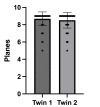Application of Semiautomatic Fetal Intelligent Navigation Echocardiography (FINE) in Twin Pregnancies: Half the Work or Twice the Effort?
- PMID: 37228519
- PMCID: PMC10207972
- DOI: 10.7759/cureus.38052
Application of Semiautomatic Fetal Intelligent Navigation Echocardiography (FINE) in Twin Pregnancies: Half the Work or Twice the Effort?
Abstract
Objective: To assess the performance of fetal intelligent navigation echocardiography (FINE, 5D Heart™) for automated volumetric investigation of the fetal heart in twin pregnancies.
Methods: Three hundred twenty-eight twin fetuses underwent fetal echocardiography in the second and third trimesters. Spatiotemporal image correlation (STIC) volumes were obtained for a volumetric investigation. The volumes were analyzed using the FINE software, and the data were investigated regarding image quality and many properly reconstructed planes.
Results: Three hundred and eight volumes underwent final analysis. 55.8% of the included pregnancies were dichorionic twin pregnancies, and 44.2% were monochorionic twin pregnancies. The mean gestational age (GA) was 22.1 weeks, and the mean maternal BMI was 27.3 kg/m2. The STIC-volume acquisition was successful in 100.0% and 95.5% of cases. The overall depiction rates of FINE were 96.5% (twin 1) and 94.7% (twin 2), respectively (p = 0.0849, not significant). In 95.9% (twin 1) and 93.9% (twin 2), at least 7 planes were reconstructed properly (p = 0.6056, not significant).
Conclusion: Our results indicate that the FINE technique used in twin pregnancies is reliable. No significant difference between the depiction rates of twin 1 and twin 2 could be detected. In addition, the depiction rates are as high as those derived from singleton pregnancies. Due to the challenges of fetal echocardiography in twin pregnancies (i.e., greater rates of cardiac anomaly and more difficult scans), the FINE technique might be a valuable tool to improve the quality of medical care in those pregnancies.
Keywords: 3d/4d; automatization; fetal echocardiography; spatiotemporal image correlation; stic; twin pregnancies; ultrasound.
Copyright © 2023, Gembicki et al.
Conflict of interest statement
The authors have declared that no competing interests exist.
Figures


Similar articles
-
Maximal Reduction of STIC Acquisition Time for Volumetric Assessment of the Fetal Heart-Benefits and Limitations of Semiautomatic Fetal Intelligent Navigation Echocardiography (FINE) Static Mode.J Clin Med. 2022 Jul 14;11(14):4062. doi: 10.3390/jcm11144062. J Clin Med. 2022. PMID: 35887826 Free PMC article.
-
Color and power Doppler combined with Fetal Intelligent Navigation Echocardiography (FINE) to evaluate the fetal heart.Ultrasound Obstet Gynecol. 2017 Oct;50(4):476-491. doi: 10.1002/uog.17522. Epub 2017 Aug 14. Ultrasound Obstet Gynecol. 2017. PMID: 28809063 Free PMC article.
-
Prospective evaluation of the fetal heart using Fetal Intelligent Navigation Echocardiography (FINE).Ultrasound Obstet Gynecol. 2016 Apr;47(4):450-9. doi: 10.1002/uog.15676. Epub 2016 Mar 10. Ultrasound Obstet Gynecol. 2016. PMID: 26278116 Free PMC article.
-
A "holistic" sonographic view on congenital heart disease: How automatic reconstruction using fetal intelligent navigation echocardiography eases unveiling of abnormal cardiac anatomy part II-Left heart anomalies.Echocardiography. 2021 May;38(5):777-789. doi: 10.1111/echo.15037. Epub 2021 Mar 29. Echocardiography. 2021. PMID: 33778977 Review.
-
Ultrasound in twin pregnancies.J Obstet Gynaecol Can. 2011 Jun;33(6):643-656. doi: 10.1016/S1701-2163(16)34916-7. J Obstet Gynaecol Can. 2011. PMID: 21846456 Review.
Cited by
-
Semi-Automatic Measurement of Fetal Cardiac Axis in Fetuses with Congenital Heart Disease (CHD) with Fetal Intelligent Navigation Echocardiography (FINE).J Clin Med. 2023 Oct 5;12(19):6371. doi: 10.3390/jcm12196371. J Clin Med. 2023. PMID: 37835015 Free PMC article.
References
-
- Congenital heart defects: the 10-year experience at a single center. Aydin E, Aypar E, Oktem A, et al. J Matern Fetal Neonatal Med. 2020;33:368–372. - PubMed
-
- Improved national prevalence estimates for 18 selected major birth defects - United States, 1999-2001. Centers for Disease Control and Prevention (CDC) https://www.cdc.gov/mmwr/preview/mmwrhtml/mm5451a2.htm. MMWR Morb Mortal Wkly Rep. 2006;54:1301–1305. - PubMed
-
- Congenital heart defects according to the types of the risk factors - a single center experience. Pavlicek J, Klaskova E, Prochazka M, et al. J Matern Fetal Neonatal Med. 2019;32:3606–3611. - PubMed
LinkOut - more resources
Full Text Sources
